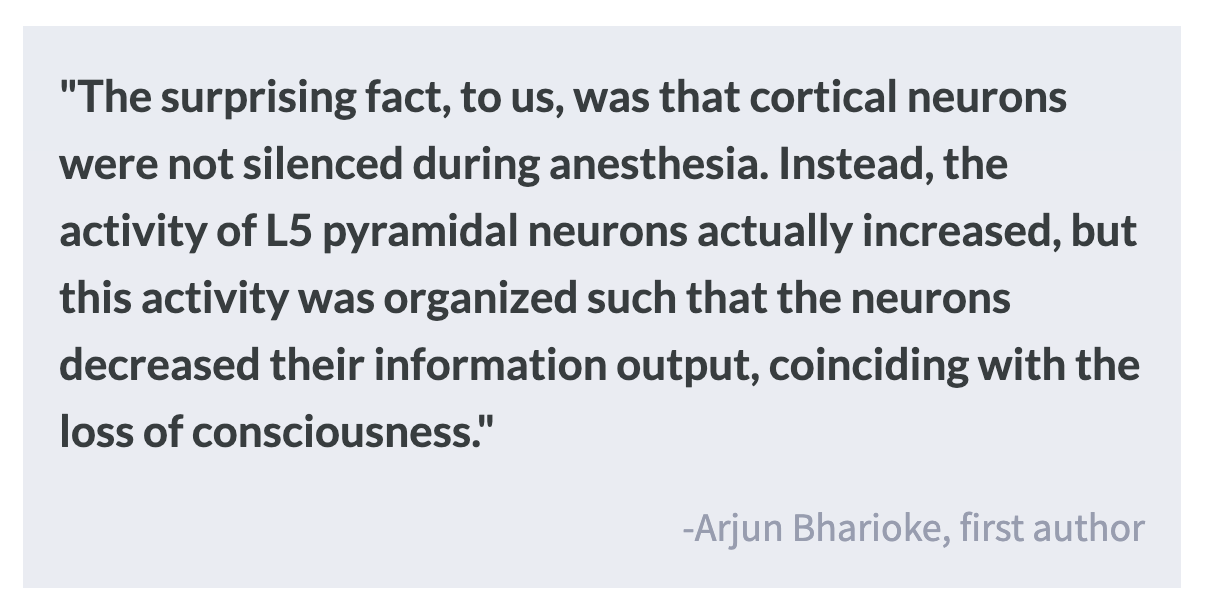Layer 5 Pyramidal Neurons Contribute to Loss of Consciousness During General Anesthesia
Post by Negar Mazloum-Farzaghi
The takeaway
Layer 5 of the brain’s cortex is a major cortical output layer. In mice, synchronous activity across layer 5 pyramidal neurons may contribute to the loss of consciousness during general anesthesia.
What's the science?
The cortex contains six layers, and each layer has distinct neuronal cell types. In particular, L5 is a uniquely organized layer with many recurrent connections. This layer contains excitatory pyramidal neurons which communicate both between cortical areas, and from the cortex to other brain areas.
All general anesthetics result in a loss of consciousness. However, different general anesthetics often induce loss of consciousness via different modes of molecular action. Despite this, unconsciousness caused by anesthesia is accompanied by common changes in cortical activity. For example, there is a common shift in the power spectrum of cortical activity to lower frequencies during unconsciousness. This shift is thought to be due to an increase in cortical synchrony. Methods used to investigate the common effects of different anesthetics on the cortex lack spatial resolution within the populations of neurons recorded or fail to distinguish cell-type specificity. Thus, in the context of general anesthesia, recording activity from many neurons of a specific type across a wide area of cortex remains to be investigated.
This week in Neuron, Bharioke, Munz and colleagues investigated features of cortical activity in individual cortical cell types that are common across different general anesthetics.
How did they do it?
In this study, the authors used three different general anesthetics: isoflurane (Iso), Fentanyl-Medetomidine-Midazolam (FMM), and Ketamine-Xylazine (Ket-Xyl). To measure spontaneous activity in specific cell types of the cortex, the authors performed in vivo two-photon calcium imaging (a technique used to monitor the activity of distinct neurons in brain tissue) from neurons in the mouse visual cortex, in genetic mouse lines labeling specific cell types. They conducted the imaging in both awake and anesthetized states. Moreover, to identify a common effect of general anesthesia, they compared the neuronal synchrony (correlation of activity of individual neurons with the activity of the remaining population) induced by FMM, Iso, and Ket-Xyl in cell types in L1, L2/3, L4, L5, and L6. Computing neuronal synchrony allows for both periodic (oscillatory) and aperiodic (non-oscillatory) alignment of activity in a neuronal population to be observed.
To further assess changes in neuronal synchrony in cortical cell types, the authors examined neuronal synchrony during the loss of consciousness and the recovery of consciousness. To examine the timing of increases in neuronal synchrony in the visual cortex during the loss of consciousness due to anesthesia administration, the authors compared probability distributions. They also examined the timing of decreases in neuronal synchrony during the recovery of consciousness.
What did they find?
The authors found that a common effect across all anesthetics was high synchrony in L5 pyramidal neurons. Each anesthetic showed different combinations of changes in synchrony and overall activity across cortical cell types (L1, L2/3, L4, and L6), with the exception of L5 pyramidal neurons. In other words, L5 pyramidal neurons were the only cell type to show a consistent increase in synchrony. Finally, the transition time of neuronal synchrony in L5 pyramidal neurons closely matched the transition time of EEG spectral power and motor behaviours that were associated with the loss and recovery of consciousness. This suggests that L5 pyramidal neurons are involved in regulating the loss and recovery of consciousness.
What's the impact?
This study found that during general anesthesia, the cortex shifts from a mode characterized by asynchronous L5 outputs to a mode characterized by synchronous L5 outputs. This change appears to be mediated by L5 pyramidal neurons, which may be involved in regulating the loss and recovery of consciousness.


